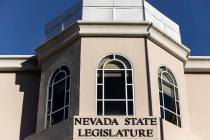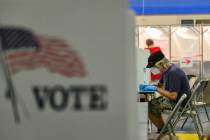Cynics rejoice: Redistricting hearings will make more of you
It's easy to grow a little bit cynical listening to arguments about how to redraw Nevada's political district boundaries.
A Democratic plan (vetoed by Gov. Brian Sandoval) would have been the gerrymander of the decade! A Republican plan will restore fairness to a system engineered for Democratic success! The Voting Rights Act calls for drawing a district with a Hispanic majority! No, wait, it doesn't, and even if it did, you couldn't do it under the law!
Those were just a few of the things heard at a public hearing on the redistricting issue Monday in Las Vegas. A second such hearing is scheduled for Carson City today.
The only consensus: Everybody feels sorry for the three "special masters" appointed by a Carson City judge to do the work lawmakers and Sandoval couldn't before the Legislature adjourned in June.
Past that, nobody agreed on anything. Attorneys for clients including Republicans said drawing a Hispanic district was perfectly allowable under the Voting Rights Act. (That's a district with a majority of overall population, but not a citizen, voting-age population. An overall Hispanic majority might be a nice gesture, but unless there are enough Hispanic voters to select a candidate of their choice, it's not very meaningful.)
Attorneys for clients including the state Democratic Party said there's no legal justification for a Hispanic district. (The Democratic map divides the Hispanic community into multiple districts.)
First cause for cynicism: There also exists a juicy political reason to confine the valley's Hispanics to a single district, which is that they tend to vote for Democrats. All the Legislature's eight Hispanic members, for example, are Democrats. Put them into a single district and you help Republicans in all the other districts.
Second cause of cynicism: Republicans arguing for a Hispanic district point to a number of races in which some white voters voted against a Hispanic candidate who was supported by the Hispanic community nearly unanimously. But in most of those cases, the Hispanic candidate won anyway, and with the help of some white voters.
"There is no evidence of racial bloc voting by the white majority in Nevada to defeat Hispanic community voting in Nevada," said Stephen Ansolabehere, a Harvard professor retained by lawyers on the Democratic side.
Republicans argued the state's existing maps -- as well as those proposed by the Democrats in the Legislature -- deny Republicans the ability to elect candidates even if Republican candidates (packed into fewer districts) get more votes. In 2010 elections, for example, Republicans got 58 percent of the votes cast in state Senate elections, but won only 48 percent of the seats. They got 55 percent of the votes in the Assembly, but won less than 40 percent of the seats.
Third cause for cynicism: Back in 2001, when lawmakers were wrangling over the last redistricting plan, they struck a compromise that created more Democratic districts in the state Legislature but tilted the state's then-new congressional seat to the GOP. It appears to have worked: That competitive congressional seat has been held by a Republican for all but two years during the past decade.
So Republicans should not now be heard to complain about the unfairness of legislative seats.
Finally, some suggested that only Hispanic residents could understand and represent a Hispanic district. "If you don't live in those districts, you don't understand the culture there," said Dr. Anette Teijeiro, speaking in favor of a Hispanic district.
But plenty of lawmakers represent people unlike themselves all the time. Just ask some of the Hispanic legislators who represent districts without a Hispanic majority today.
Steve Sebelius is a Review-Journal political columnist and author of the blog SlashPolitics.com. Follow him on Twitter at www.Twitter.com/SteveSebelius or reach him at (702) 387-5276 or ssebelius@ reviewjournal.com.

















